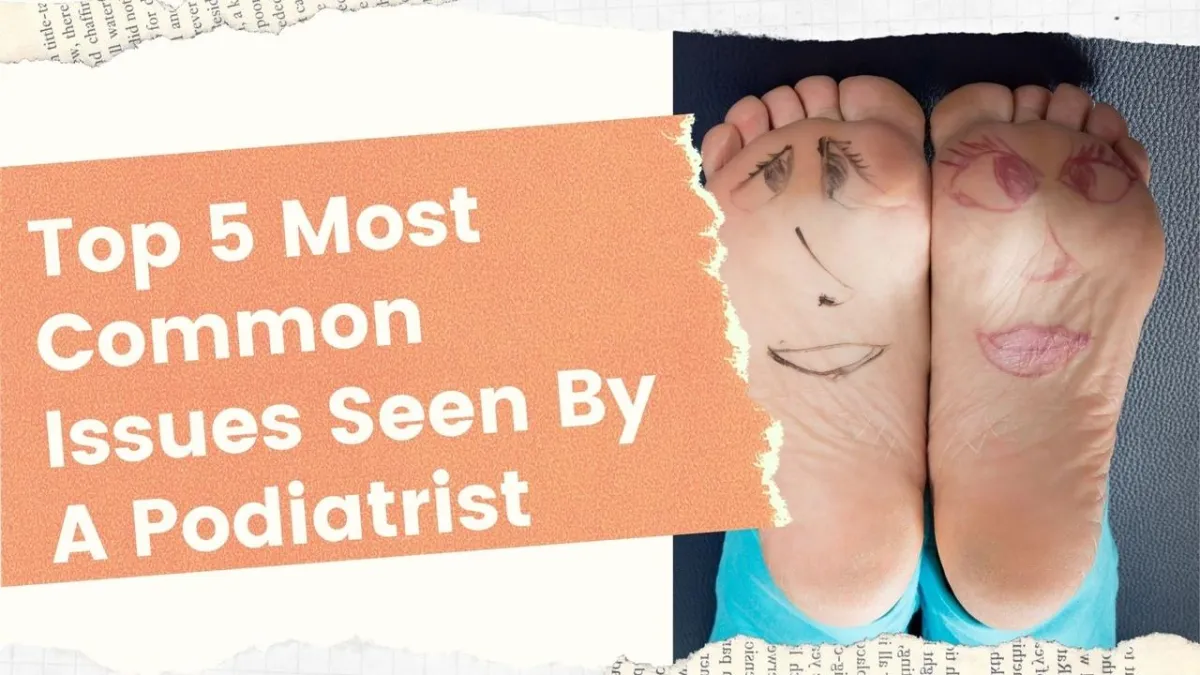Tips & Advice From South Dublin Podiatry

Top 5 Most Common Issues seen by a Podiatrist
Ingrown toenails
Ingrown toenails occur when the edge of the toenail curls down and can grow into the skin and soft tissue. Ingrown toenails can be very painful and can cause swelling, redness and pus to be present in the nail bed.
They can be treated at home but if there are any signs of infection or you are having trouble cutting the nail it is important to see a podiatrist.
Tips:
The nails should be trimmed regularly making sure there are no spikes of nail left and that they are not cut in a rounded shape.
The nails should be soaked in a basin of warm water and salt after cutting an ingrown toenail to help to keep the area clean and clear from any bacteria
Wearing good fitting footwear can help to keep pressure off the toes and prevent them from becoming ingrown.
Corns
Corns are small areas of callus that often have a root. They develop due to pressure on any prominent areas of the foot. They can also occur due to pressure caused by footwear.
Corns usually develop of the ball of the foot, on the toes and even between the toes.
Treatment
The main treatment for corns is removal with a scalpel by a podiatrists
At home treatment
Felt padding or some bandages can be used to protect and offload pressure from vulnerable areas.
An Emory board or pumice stone can be used to file down any hard skin or corns. It is a good idea to do this in between podiatry appointments to help slow down the return of the callus.
Soaking the feet before filing the hard skin helps to soften it and applying a moisturizing foot cream
Verruca's
Verruca's are plantar warts caused by the Human Papilloma Virus. The virus enters the skin through broken skin.
How to spot a verruca:
Small lump of skin that can also form in a cluster of multiple verruca's
Black dots in the skin (blood vessels)
Pain from the lesion when walking
Pain when the lesion is squeezed from the sides
Treatment in South Dublin Podiatry
During a chiropody appointment, your Podiatrist will assess the Verruca's, discuss treatments and recommend the best treatment option for you.
Onychauxic nails (thickened nails)
This is a condition that causes the nails to become abnormally thick. The nails often become discolored and can separate from the nail bed. If this occurs due to trauma the damaged nail may fall off and a new nail will grow up under it.
Causes:
Trauma
Poor blood flow
Genetics
Diseases such as diabetes
It is important to cut and file the nails regularly. It is easier to do this after bathing the feet as the nails will be softer. If the nails are too difficult to cut a podiatrist can use an electric drill to thin the nail and cut them back
Heel Pain
Heel pain is a common problem. It can occur under the heel and at the back of the heel where the Achilles’ tendon inserts onto the heel bone.
Flat, unsupportive footwear and foot abnormalities such as very high or low arches can contribute to heel pain.
Rest: it is important to rest the foot if you are suffering from heel pain. Avoid running or standing for long periods of time, especially on hard surfaces.
Ice: ice the painful area once a day for 20 minutes. It is important not to place ice directly onto the skin. Wrap the ice in a cloth or tea towel to protect the skin.
Massage the area: a cold can or a tennis ball can be used to roll out the heel.
Footwear: good footwear that are well fitting and supportive are essential. Flat and slip on shoes can make the problems worse
A podiatrist can prescribe custom foot orthotics that can help correct and biomechanical issues which may be contributing to the heel pain
A podiatrist can recommend stretches such as calf stretches to help stretch out the calves and relieve any strain on the Achilles tendon.
Diabetic Neuropathy
Diabetics may suffer from a loss or a reduction of sensation in the feet as prolonged high glucose levels can damage the nerves. A podiatrist can carry out a quick test to determine if there is any loss or reduction in the sensation in the feet.
Diabetic neuropathy can cause burning, tingling, numbness and shooting pains in the feet.
Tips:
check your feet daily, making sure to look in between the toes and on the sole of the foot. A mirror can be used to do this.
If you have any nail problems, callus or corn be sure to visit a podiatrist as these can lead to breakdown and other problems if they’re not treated properly.
Apply cream to the feet daily and avoid applying it in between the toes.
See a podiatrist if you’ve any other foot problems such as a cut or a sore.
Make sure that the shoes are well fitting and that there is enough room to accommodate any foot deformities.
For more information on why footcare is essential for people with diabetes, have a read of one of our blogs on The Connection Between Feet and Diabetes
Call Us Now On: 📞01 9012009
or
Fill Out The Form Below And Request A Call From Our Team
Ask South Dublin Podiatry And Their Team
Fill in the form to request a Call From Our Team
One of our team members will call you for FREE and answer any questions or concerns you may have about your condition




